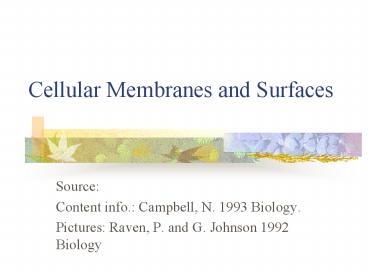Cellular Membranes and Surfaces - PowerPoint PPT Presentation
Title:
Cellular Membranes and Surfaces
Description:
Structure present in the cells of prokaryotes, fungi, plants and some protists ... strong fibers surrounded by an amorphous matrix is the same basic architectural ... – PowerPoint PPT presentation
Number of Views:20
Avg rating:3.0/5.0
Title: Cellular Membranes and Surfaces
1
Cellular Membranes and Surfaces
- Source
- Content info. Campbell, N. 1993 Biology.
- Pictures Raven, P. and G. Johnson 1992 Biology
2
CELL WALLS
- Structure present in the cells of prokaryotes,
fungi, plants and some protists - Protects, maintains shape, prevents excessive
uptake of water. - Help support the plant against gravity.
- Plant cell walls are thicker than the cell
membrane (from 0.1 to several um) - Composition varies from species to species, from
cell to cell.
3
Cell Wall Composition
- Fibers made up of polysaccharide cellulose are
embedded in a matrix of other polysaccharides and
protein (See fig. 5.10 text). This arrangement of
strong fibers surrounded by an amorphous matrix
is the same basic architectural design found in
steel-reinforced concrete and fiberglass.
(Campbell, 1993)
4
Glycocalyx
- Many animal cells have a fuzzy coat called
glycolcayx - The glycocalyx is made up of a sticky
oligosaccharide that attach by covalent bonds to
both the proteins and lipids of the plasma
membrane. - It provides strength to the cell surface and
helps glue cells together. - The oligosaccharides contribute to cell-cell
recognition.
5
Cell membraneThe fluid-mosaic model
- Study the following diagram and the information
in your textbook (p. 152) and then explain the
following
6
- Explain the reason and importance of thefluid
quality of the cell membrane. - Explain why membranes are mosaics of structure
and function. - Describe the benefits of the amphipathic nature
of the cell membrane - Define passive transport, osmosis and diffusion,
hypotonic, isotonic, hypertonic - Explain the role of the cell membrane in
reference to osmosis and diffusion - The following diagrams comes from Raven, Peter
Biology (class Textbook)
7
(No Transcript)
8
(No Transcript)
9
- Active Transport Pumps
10
Classwork
- Draw and describe the role of the cell membrane
components. - Find info. about the Fluid Mosaic Model of the
Cell Membrane - History
- Description of the membrane































